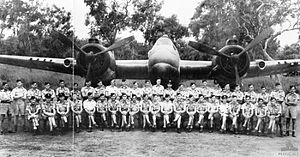No. 9 Operational Group RAAF
| No. 9 Operational Group RAAF | |
|---|---|

Personnel of No. 30 Squadron, part of No. 73 Wing, No. 9 Operational Group, with a Beaufighter in New Guinea, 1943
|
|
| Active | 1942–44 |
| Country | Australia |
| Branch | Royal Australian Air Force |
| Role | Fighter; ground attack |
| Size | Two combat wings |
| Engagements |
World War II |
| Commanders | |
| Notable commanders |
Bill Garing (1942–43) Joe Hewitt (1943) Frank Lukis (1943–44) |
| Aircraft flown | |
| Attack | Beaufort; Beaufighter |
| Bomber | Hudson; Boston |
| Fighter | Kittyhawk |
World War II
No. 9 Operational Group was a major Royal Australian Air Force (RAAF) formation providing fighter, ground-attack and anti-shipping support to the Allies in the South West Pacific theatre during World War II. Established in September 1942, it acted as a mobile striking force independent of the RAAF's static area commands. As the war in the Pacific progressed, No. 9 Operational Group itself developed into an area command called Northern Command, responsible for garrisoning New Guinea.
No. 9 Operational Group (No. 9 OG) was formed in New Guinea in September 1942, consisting of seven RAAF squadrons attached to the USAAF's Fifth Air Force. Four of the squadrons were based at Milne Bay and three at Port Moresby. On its establishment it was the RAAF’s "premier fighting unit" in the South West Pacific Area (SWPA). Its first commander was Group Captain Bill Garing.
Administratively, No. 9 OG initially came under the control of RAAF North-Eastern Area Command. On 1 January 1943, Headquarters No. 9 OG assumed responsibility for the formation’s administration as well as its operations, making it independent of North-Eastern Area. Air Commodore Joe Hewitt became Air Officer Commanding No. 9 OG in February 1943. The same month, the Group's squadrons were reorganised into two wings: No. 71 Wing, covering the units in Milne Bay, and No. 73 Wing, those in Port Moresby.
...
Wikipedia
